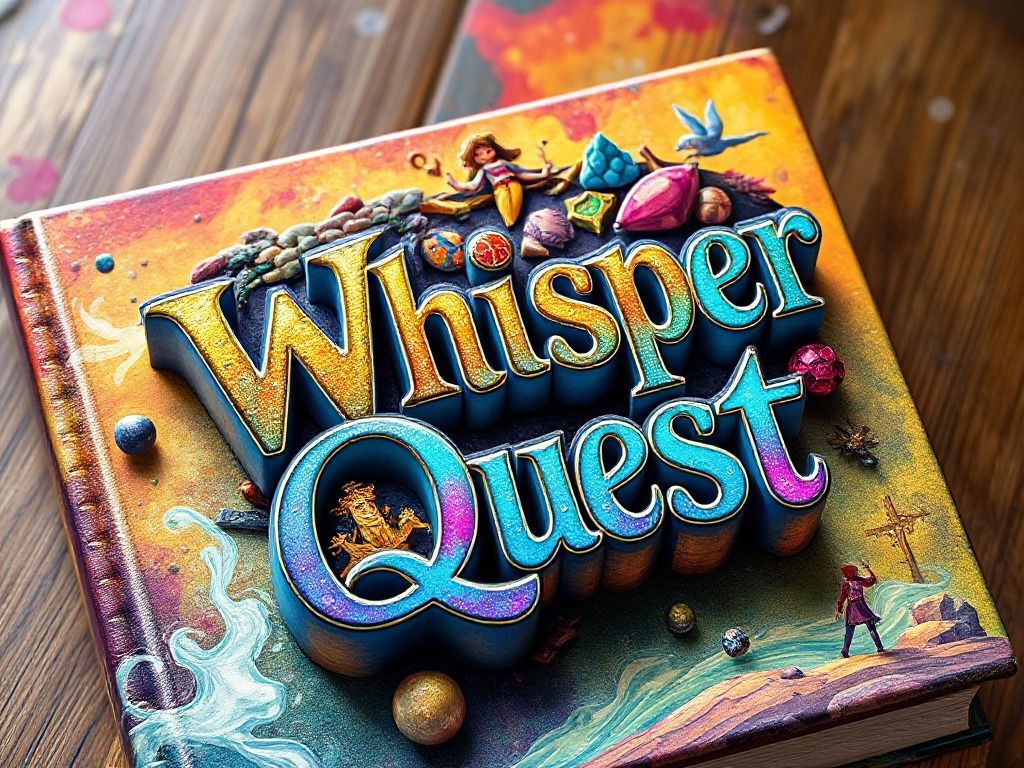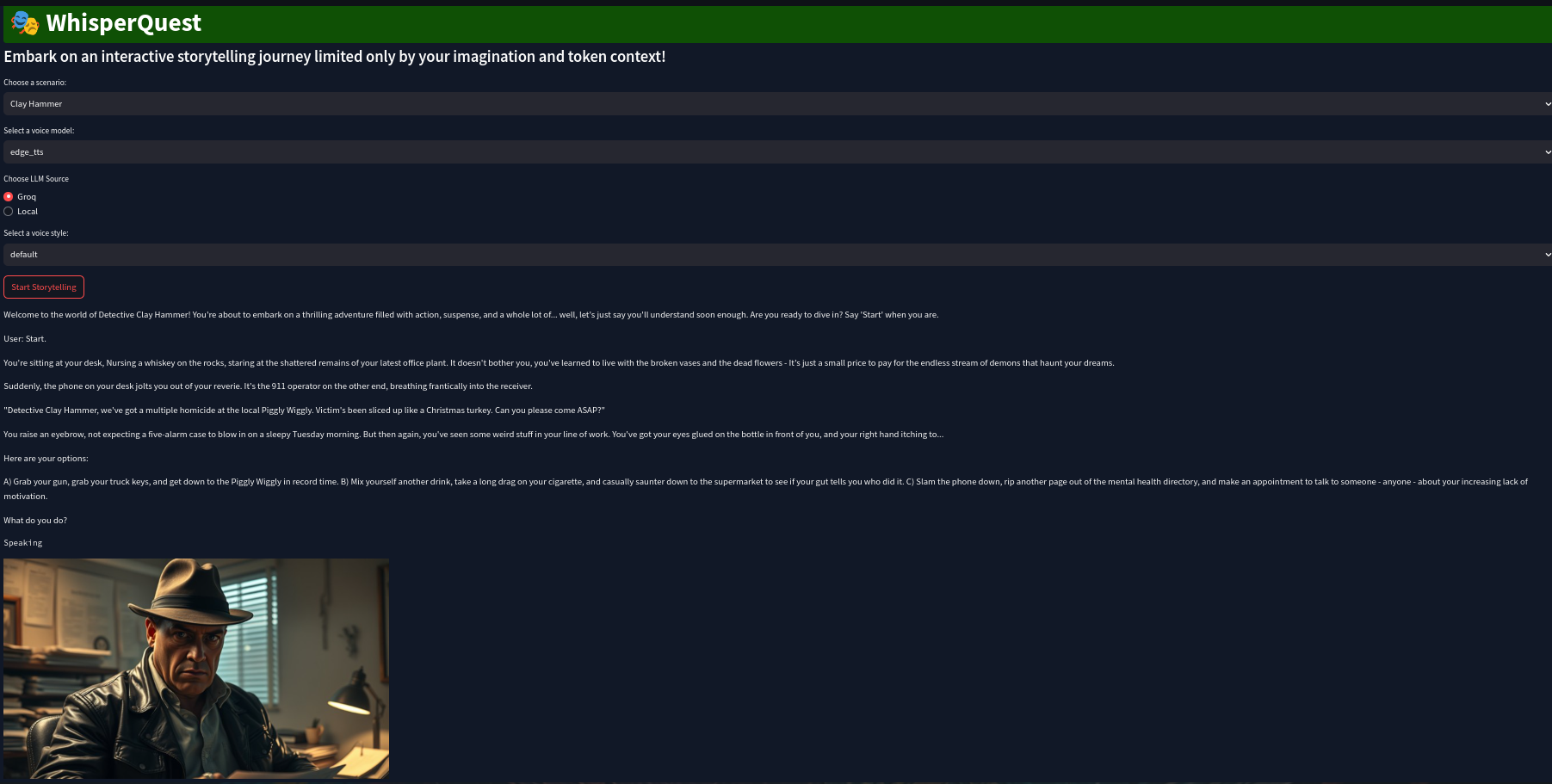Modified Non-Commercial Creative Commons Attribution-NonCommercial-ShareAlike 4.0 International Public License (Translation- free for all but you need to give me credit and buy a license if gross revenues are above $100K)
Please consider contributing, or donating if you enjoy my work:
💰 BTC: bc1q8lc4mzdtdyz7fx44vaw3jn8qg6w4c3ypfxpdrv
💰 ETH/MATIC: 0x102a6fd187db8441d2cbead33ac70e87f382f114
💰 ZEC: t1LfMiD21xGkZYhD2XSNprKp6vf9xQdgd2E
This program provides a fun and engaging interactive storytelling experience via voice input/output.
🎤 Voice-Controlled Interaction: Speak your choices to advance the story, making it feel like a real interactive adventure. Feel free to make up crazy choices as you go along, and see how the LLM responds!
📚 Storytelling with Different Genres: Choose from the default Thriller scenario, or create your own custom story.
🗣️ Dynamic Voice Generation: The story can be spoken aloud with different voice styles if using OpenVoice, making the experience even more immersive. Plus 5 other speech options!
🎙️ Voice Cloning: Use reference audio with OpenVoice to personalize the story's voice with your own voice.
🖼️ Scene Image Generation: Visualize the scenes with AI-generated images based on the narrative. Currently the the Pollinations API is used for this purpose..
🤖 Multiple LLM Integration: Choose between running the story on your local LLM or using the Groq API for powerful AI generation.
🖼️ Improved Image Generation: Uses Pollinations API to generate scene images with Flux.
💻 Resource Management: The current implementation can be resource-intensive, especially when using local language or voice models, particularly at long context lengths.
🐛 Robustness: The codebase is under development, and there might be unexpected behaviors or crashes. Specifically, when using local models, or when using OpenVoice, expect degraded performance and possible system instability especially after multiple turns. Note: There appears to be an intermittent bug or glitch with Groq, where it will generate word salad. This can lead to images occasionally being random or the story turning into gibberish. If this happens, simply restart it, and it should work! Addendum: Even when using a small/tiny whisper model, and Groq, and edge_tts, it can take a few seconds for audio transcription, llm response generation, and image fetching to all complete. This adds a bit of latency so, when the LLM asks you to respond, give it a few seconds, and wait for the image and response to display in the UI, before making your choices.
🔊 Audio Quality: The audio generated by some voice models may vary in quality. You only need to install the ones you want to use, or you can use edge_tts API for fast and free speech output if you have an internet connection, or you can use UnrealSpeech with their free API key. If you have a GPU or don't mind waiting a few minutes, you can use OpenVoice and a clip of your voice or someone else's to generate a realistic voice clone that will voice your story. If you want it faster and on CPU, you can use yourtts, or for mid-range quality, try xttsv2. (Note: Some local tts/cloning options such as OpenVoice may use RAM inefficiently - known bug)
🎨 User Interface Enhancements: Refine the user interface for a more seamless and intuitive user experience.
🎧 Scenario Soundtracks: Rad music to listen to while awaiting local llm/voice generation, or just because.
📚 Documentation and Testing: Enhance the program's documentation and implement more comprehensive testing for improved reliability.
#1. 📦 Install Requirements: Make sure you have all the necessary libraries installed. You can install them with:
pip install -r requirements.txtFor OpenVoice voice cloning support, visit OpenVoice GitHub.
#2. 🔧 Setup Environment Variables:
🔑 GROQ_API_KEY: Set the GROQ_API_KEY environment variable in config.py to your Groq API key if you plan on using Groq for LLM generation. You can find your Groq API key in your Groq account settings.
💻 Local LLM Setup (Optional): If you are using a local LLM server, ensure it is running and set the BASE_URL environment variable to your LLM server's base URL. You might also need to adjust the API_KEY variable in aimodels/llm_models.py depending on your LLM setup.
#3.
python main.py#4. 🎮 Interact with the Interface:
📝 Choose a Scenario: Select a pre-defined scenario (Thriller) or input your own custom scenario in the provided text box.
🗣️ Select a Voice Model: Choose from different voice models, including edge_tts, MeloTTS, OpenVoice (Supports Voice Cloning!), xttsv2, yourtts, or UnrealSpeech (get a free API key at UnrealSpeech).
🤖 Select LLM Source: Choose between "Local" (using your local LLM server) or "Groq" (using the Groq API).
🎧 Reference Audio (Optional): Upload audio to clone the voice of the story with your own voice. This will personalize the narration with your voice.
🎭 Voice Style: If using OpenVoice, select a specific voice style (e.g., whispering, cheerful, angry) for the story's narration.
🖼️ Enable Image Generation: Enable this option to see AI-generated images of the story scenes.
🎙️ Speak your Choices: The game will listen to your voice commands. Choose from the options presented to advance the story.
The application uses OpenVoice for voice cloning, allowing you to create a unique voice for the story based on a reference audio recording. When you upload reference audio, the application analyzes its characteristics and uses them to synthesize a similar voice for the narration.
Planned/Not fully implemented: With image generation enabled, the application utilizes an AI model (currently Segmind API) to generate images based on the story's scenes. The LLM will provide descriptions of the scenes, and the image generation service will create corresponding images. This is commented out at the moment.
📂 main.py: The main entry point for the application. Initializes the Streamlit interface and starts the story service.
📂 ui/streamlit_ui.py: Contains the Streamlit UI code, defining the user interface elements and their interactions.
📂 services: A directory containing various service modules:
- story_service.py: Handles the logic for generating the story, managing messages, and interacting with the LLM.
- audio_service.py: Responsible for generating and playing audio, using the selected voice model and style.
- image_service.py: Handles the image generation process, utilizing the Pollinations API. (Not fully implemented)
📂 aimodels: A directory containing code for AI models:
- llm_models.py: Defines different LLM models (LocalLLMModel and GroqLLMModel) for generating responses.
- tts_models.py: Contains code for TTS models, including OpenVoiceModel.
You can deploy the application using Docker. Create a Dockerfile with the following contents:
FROM python:3.10
WORKDIR /app
COPY requirements.txt ./
RUN pip install --no-cache-dir -r requirements.txt
COPY . .
EXPOSE 7860
CMD [streamlit run main.py]Then, build the Docker image:
docker build -t storyteller .Finally, run the container:
docker run -p 7860:7860 storyteller#1. Run the application: streamlit run main.py
#2. Choose a scenario. Enter in your custom scenario, if desired.
#3. Select "OpenVoice" for the voice cloning model, or leave it as is, to use Microsoft's edge_tts API. Aug 29: Added Melo TTS for fast Real time TTS on CPU:
git clone https://github.com/myshell-ai/MeloTTS.git
cd MeloTTS
pip install -e .
python -m unidic download
#4. Choose "Local" for the LLM source if you would like to use a local model, or leave it on Groq (set your API key in the config first!) to have near-instant text generation.
#5. Upload a reference audio if using OpenVoice.
#6. Optionally, select a voice style (if using OpenVoice to make a voice clone).
#7. Enable image generation to see graphics from Pollinations API for each scene.
#7. Click "Start Story".
#8. You'll hear the welcome message: "Welcome to the WhisperQuest, the infinite story game. Are you ready to begin your adventure? Say 'Start' when you're ready."
#9. Speak "Start".
#10. The story will continue based on your spoken choices.
#🎉 Enjoy your immersive adventure!

